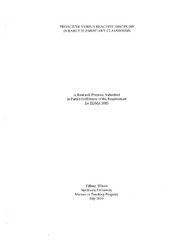Proactive Versus Reactive Discipline in Early Elementary Classrooms
Abstract
Is classroom management the most important factor in establishing an effective learning environment? Many educators would argue that learning can only take place once a successful classroom management plan is in place. Classroom management is a widely studied topic among educational researchers. Specifically, researchers have studied the difference between proactive and reactive methods. Historically, research has taken a reactive approach in addressing the issue of classroom management. Current trends are leaning towards a proactive approach; many researchers are finding that students respond positively when a teacher is able to effectively implement a Positive Behavior Support Model. The data I collected consisted of semi-structured interviews with three second grade teachers and observation logs collected from the three second grade classes. In examining the data, I was able to identify the current methods these teachers use. Furthermore, I looked at how the method used affects classroom morale and prevents potential misbehavior. I found that a proactive approach allows teachers to spend more time teaching valuable material and less time reprimanding negative behavior. Teachers should only use reactive discipline as a secondary approach to classroom management. If a problem persists with individual students a specific behavior plan should be established. With a well implemented classroom management plan students are set up for academic success and teachers are able to spend less time and energy addressing misbehavior.
Original item type
PDF
Original extent
iii, 36 pages
Subject
Copyright
This original work is protected by copyright. Copyright is retained by the author(s). Works may be viewed, downloaded, or printed, but not reproduced or distributed without author(s) permission.


 Maintained by the Northwest University Library
Maintained by the Northwest University Library